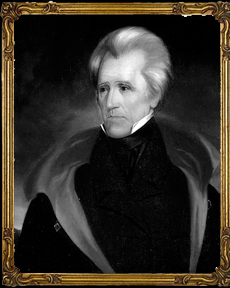
Andrew Jackson
Term Date: 1829-1837
Political Party: Democratic
Vice President: John C. Calhoun; Martin Van Buren
Born Place: Waxhaw, South Carolina
Born Date: March 15, 1767
Died Place: Hermitage in Nashville, Tennessee
Died Date: June 8, 1845
First Lady: Rachel Donelson Robards
Children: 1 (adopted)
Parents: Andrew Jackson, Elizabeth Hutchinson
Other Political Offices:
U.S. House of Representatives
United States Senator, 1797-98
Justice on Tennessee Supreme Court
Governor of the Florida Territory
United States Senator
Occupation before elected:
Lawyer, soldier
Brief History:
He was the first man elected from Tennessee to the House of Representatives, and served in the Senate. A general in the War of 1812, Jackson became a hero after defeating the British at New Orleans. Jackson restructured the presidential office and helped mold the Democratic Party. He won by popular vote due to his victories and overall personality for being known as a strong leader. Under his leadership in 1835 the United States became debt free (briefly) for the only time in history. One of the most pressing problems of Jackson's presidency was how to remove Native American's from their lands in the Southwest. Professing concern for their welfare under The Indian Removal Act of 1830, Jackson proposed to moving them to in present-day Oklahoma. The policy was a disaster.
Thousands of the Cherokee nation perished on the "Trail of Tears," a forced march of over 800 miles. By the end of the 1830s, nearly all Native Americans to the East had been resettled in the West. During Jackson's presidency his refued to sanction the recharter of the Bank of the United States. Jackson thought Congress had not had the authority to create the Bank in the first place. During his term two states were admitted to the Union (Arkansas in 1836 and Michigan in 1837). He remained a force in the Democratic party. But his last years were occupied by financial distress resulting from the debts of his adopted son, Andrew Jackson, Jr. Jackson retired to his home near Nashville which he named The Hermitage. When the Hermitage was built it was little more than a small cabin, but by his retirement it had been expanded and remodeled into a spacious plantation house.
Thousands of the Cherokee nation perished on the "Trail of Tears," a forced march of over 800 miles. By the end of the 1830s, nearly all Native Americans to the East had been resettled in the West. During Jackson's presidency his refued to sanction the recharter of the Bank of the United States. Jackson thought Congress had not had the authority to create the Bank in the first place. During his term two states were admitted to the Union (Arkansas in 1836 and Michigan in 1837). He remained a force in the Democratic party. But his last years were occupied by financial distress resulting from the debts of his adopted son, Andrew Jackson, Jr. Jackson retired to his home near Nashville which he named The Hermitage. When the Hermitage was built it was little more than a small cabin, but by his retirement it had been expanded and remodeled into a spacious plantation house.

